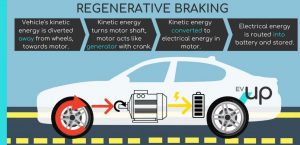From UPSC perspective, the following things are important :
Prelims level: Regenerative Braking and its Working
Why in the News?
The Regenerative Braking device market is set to witness immense growth during the period 2024-2031 due to rise in prominence of e-vehicles.
What is Regenerative Braking?Regenerative braking is a technology used in electric and hybrid vehicles to capture and reuse energy that would otherwise be lost during braking. How Does It Work?
Significance:
Example: Imagine riding a bicycle down a hill. Normally, if you press the brakes, you slow down and the energy goes away as heat. But if you could somehow capture that energy and use it to help you pedal back up the hill, that would be similar to what regenerative braking does in a car.
|
How does a Motor become a Generator?
- A motor consists of a rotor (which rotates) and a stator (which is stationary).
- The stator contains magnets or electromagnets, while the rotor has current-carrying coils.
- The Lorentz Force acts on the charged particles in the magnetic field, causing the rotor to spin.
- In a generator, mechanical energy induces a current in the stator EVs can implement regenerative braking by switching the traction motor between these configurations.
Downsides of Regenerative Braking
- Regenerative braking alone often cannot bring a vehicle to a complete stop and must be supplemented by conventional braking systems.
- Regenerative brakes may not prevent vehicles from backsliding downhill.
- The efficiency of energy recovery drops as the vehicle’s speed decreases, though regenerative brakes are beneficial in stop-start traffic.
Other Ways to Recover Energy
- The design of a regenerative brake depends on the form of energy conversion. EVs convert mechanical energy into electrical energy stored in batteries or supercapacitors.
- Flywheels can store mechanical energy by increasing angular momentum, useful in applications like Formula One racing and satellite navigation.
- Kinetic energy can also be used to compress air, which can be useful for starting internal combustion engines.
| PYQ:
[2021] Magnetite particles, suspected to cause neurodegenerative problems, are generated as environmental pollutants from which of the following? 1. Brakes of motor vehicles 2. Engines of motor vehicles 3. Microwave stoves within homes 4. Power plants 5. Telephone line Select the correct answer using the code given below. a)1, 2, 3 and 5 only b)1, 2 and 4 only c)3, 4 and 5 only d)1, 2, 3, 4 and 5 |
Get an IAS/IPS ranker as your 1: 1 personal mentor for UPSC 2024

